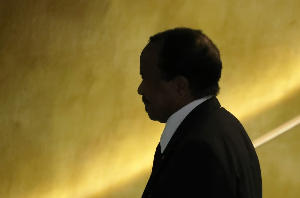Insufficient electricity production, obsolete transport infrastructure, drop in Sanaga River... need emergency solutions for incessant darkness to be history.
Installed electricity capacity in Cameroon is in the neighbourhood of 1,299 megawatts with Eneo, the outfit in charge of the generation, transmission and distribution of the produce, having a lion’s share of 997 megawatts.
Statistics show that independent producers like the Dibamba Power Development Company (DPDC) and Kribi Power Development Company (KDPC) complete the rest with 86 MW and 216 MW productions respectively. This overall production comprises 732 MW from hydro sources (57 per cent), 281 MW from thermal fuel (22 per cent) and 266 MW from thermal gas (21 per cent). Target is to hit 3,000 MW by 2020.
As good as this may sound, people are increasingly looming in the dark for want of the produce in quality and quantity. National demand of the produce, authorities say, has moved from averagely 6 per cent in 2001 to 7.5 per cent since 2010.
Records show that the electrification rate in the country is around 50 per cent with over 90 per cent of the population still using traditional heating tools like firewood and charcoal. What is rather disturbing is the fact that even where electricity exists, subscribers cannot determine when and how to use the produce owing to what is now commonly known in the country as ‘epileptic power supply.’
Obsolete Transport Infrastructure
Electricity generation is as important as transmission and distribution to those in need. This seems to be the missing link in the country’s electricity chain.
Transformers blowing here and there and electricity poles falling like a pack of cards is no longer a novelty here. Authorities themselves confirmed that the main problem plaguing the country’s electricity sector is old equipment - wooden poles, cables, overloaded and outdated transformers.
According to John Sanyi, new Regional Director of Eneo Cameroon SA for the East Region, over 500,000 wooden poles have to be replaced to the tune of FCFA 37.2 billion. The outfit, he said, is carrying out the replacement at a speed of 40,000 poles or more a year.
Basic arithmetic here shows that at this pace, the pressing problem can at best get a definite solution in not less than twelve and a half years. Even if the poles were to be replaced at short notice, skeptics still doubt the quality of what the distributor is using today to replace what has worn out.
Old treated poles had a lifespan of 20 years but what is being used today appears not to be going through the same hitherto treatment procedure and may not stand the test of time. This raises more fears than hopes given that in the over 12 years that the replacement will span, other poles would have outlived their usefulness and other problems resurfaced.
This even casts a dark cloud on the much-heralded giant hydroelectricity dams under construction. They will at term obviously augment national production but the final consumer risks not journeying out of darkness for want of means to move the produce from the national grid to industries and households for use.
Drop in Water Flow
Another reason advanced for the current shortfall in supply is the drop in the flow of River Sanaga, the lowest in 30 years. Between May 14 and June 3, 2015, the river witnessed a sharp drop making it difficult for effective electricity generation like before.
There is therefore need for urgent measures to be drafted and fully implemented to salvage the growing energy problems starring the country in the face so as to give the population convenient access to the rather basic commodity. Where there is light, there is life!
Opinions of Wednesday, 10 June 2015
Auteur: Cameroon Tribune















